By Rick VanSickle
The new Dobbin Estate winery on the Twenty Mile Bench is a showpiece for the region and will help raise the bar for luxury Niagara wines in the years to come.
I know, a big declaration, but after touring and tasting the wines recently there is no doubt this boutique estate winery and organic vineyards, located just south-east of The Farm Wines off King St., will emerge as one of the benchmarks for the varieties it is choosing to champion — Chardonnay, Riesling, Cabernet Franc, and Pinot Noir — under the guidance of consulting winemakers and viticulturists Peter Gamble and Ann Sperling.
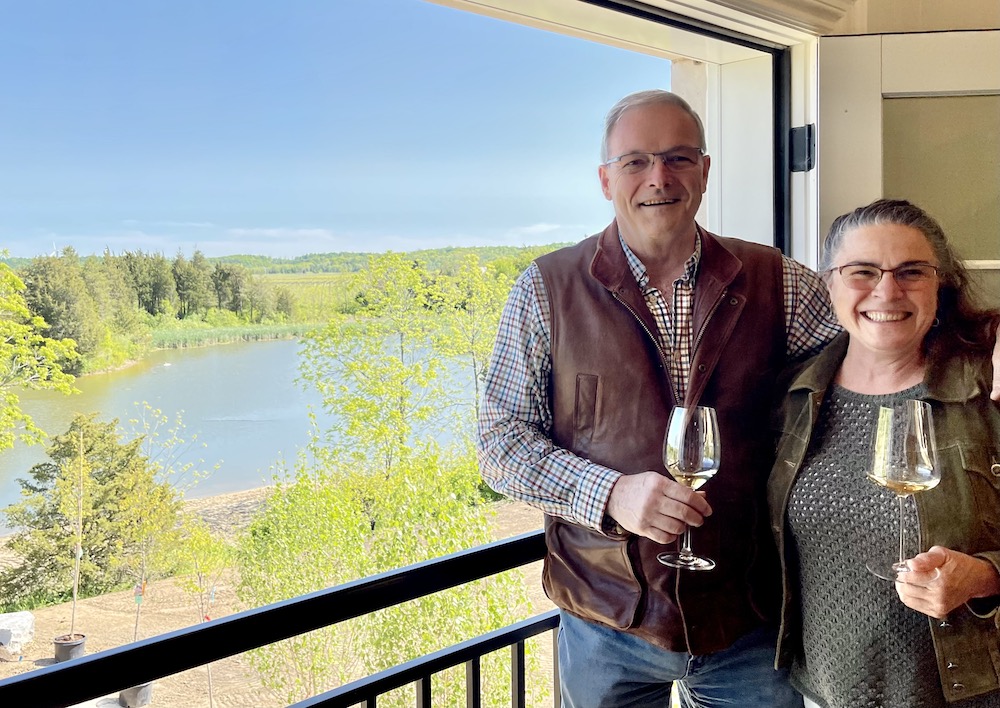
Arriving at the estate on a sunny spring day, the winding, almost hidden driveway leads past the neatly groomed, most westerly vineyard at the former Laura Sabourin farm. Past the estate house and around a bend, the scope of the project begins to unfold.
Punctuated by an ornate, grand tower that offers near panoramic views of the freshly replanted north-sloping, south-sloping and western Charlene vineyards that are bordered by forests and separated by a seven-acre pond with swans serenely paddling by you get a true sense of the financial commitment here.
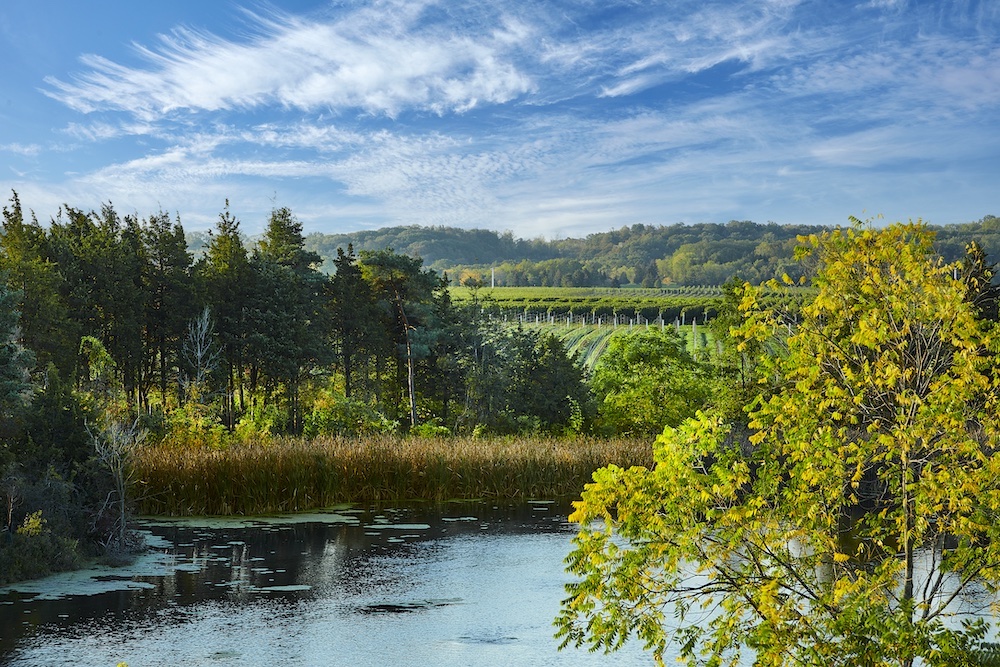
Wade Dobbin, a land developer who started as an industrial real estate agent and then he and his partner created the Canadian arm of Panattoni, an international development company, bought the property in 2018 and his first order of business was to bring Gamble and Sperling into the fold to re-imagine the property and vineyards and create the finest wines possible from what will grow best in the vineyards.
“When Wade first asked me if I knew the vineyard site, I said that I knew it well and that Ann and I thought that it was potentially the most beautiful vineyard site in Niagara,” Gamble recalled. “With some landscaping it could be Blenheim (the palace, one of England’s largest “houses” built between 1705 and 1722 and designated a UNESCO World Heritage Site in 1987). Wade laughed and said that he and his wife Faye had visited as many famous gardens in the world as they had wineries, and that gardens were a passion of theirs and definitely a part of their plan for the property.”
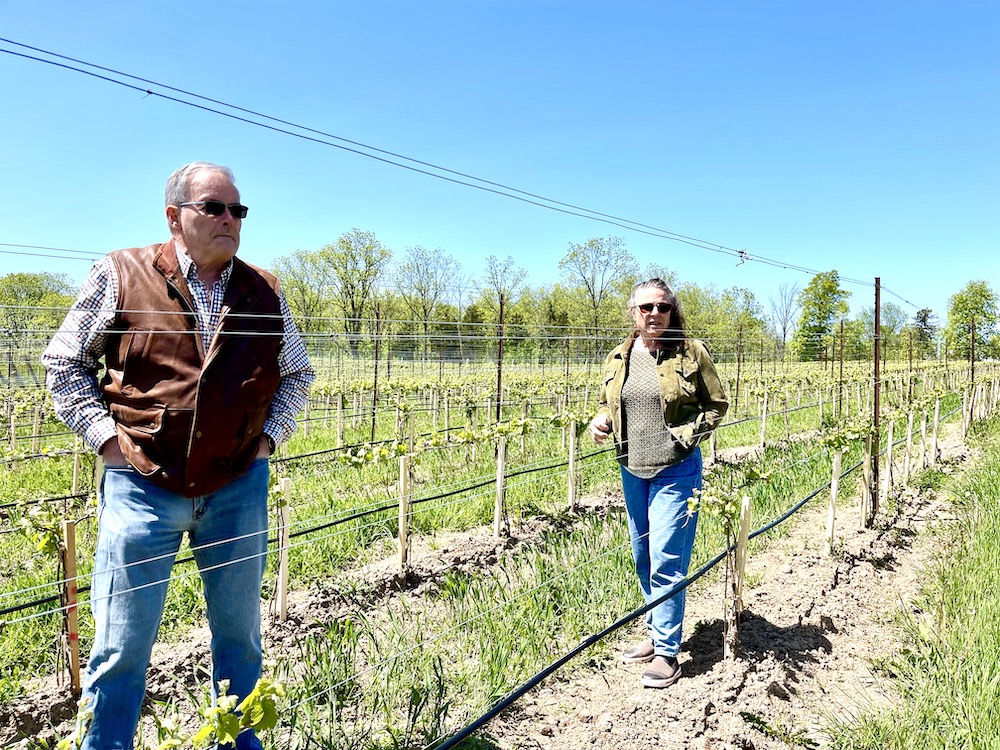
Gamble said Dobbin mentioned the Quatre Vents gardens in Charlevoix, Quebec, as an example of a beautiful Canadian garden they knew and that towers were often an important focal point in traditional formal and informal gardens through the years. “He (Dobbin) always admired them and that he really wanted to do one right away at the site. We agreed that it could house a fabulous, elevated tasting room overlooking the lake and vineyards, and Wade quickly got it underway.”
It certainly is a focal point of the property, viewed from every point on the estate, with three storeys that features a tasting room and intimate private room available for tastings of up to 10 people and VIP events.
On the day Wines in Niagara visited, at team of landscapers was busy planting trees, shrubs and grass surrounding the tower that sits on the edge of the pond. An island in the pond was being refurbished to add another element to the experience at Dobbin.
Did I mention that money is no object with this unique and super-premium new winery?
“This is Wade’s love letter to Niagara,” said Sperling, who takes care of the viticultural side of the Dobbin project (with Gamble taking care of the winemaking). Sperling, Gamble and Dobbin’s nephew, Nathan, who is the general manager of the estate, all agree on one thing in particular: To make the experience at the new project complement the kind of wines being crafted. “We’re big on experiences,” said Nathan Dobbin. “This is an experience here that will match the wines.”
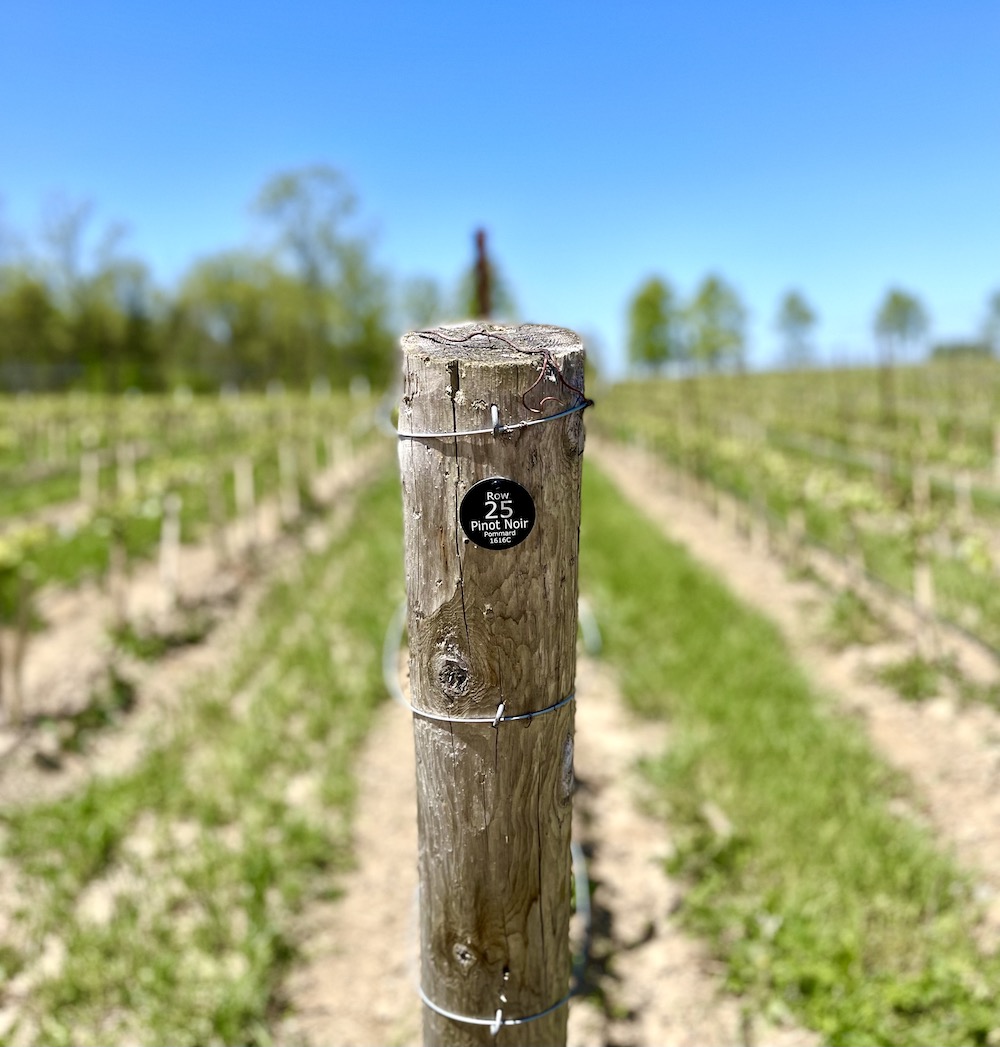
With the estate now open for booking experiences that includes tasting four wines on offer with matching dishes by the estate’s consulting executive chef, Laura Ramik, and an opportunity to be among the first to purchase the wines, consumers can book a tasting for 10 in the tower for a fee of $900, a savings of $300 (called the “hard-hat special”) while the landscaping is being completed.
The wines range in price from the $60 and $65 Rieslings, $75 Chardonnay, $260 “estate” Chardonnay in magnum, and $80 Cabernet blend. Production is pegged in the 2,000-case range going forward and the plan is to keep it that tiny (with an option for 500 more cases if Gamble and Sperling source some interesting grapes from trusted growers). Expensive, yes, and at the highest end for Niagara wines, but Gamble and the team believe there is a growing market for the premiumization of Ontario wines. “Is price holding back making the best wine,” Gamble asks rhetorically. “The times are changing; the clientele is willing to spend more and we’re in a really good place to make very good wine.”
Gamble isn’t wrong; premiumization is a topic being discussed in many wine circles in Niagara. Wineries in the Okanagan Valley in B.C., with a lot of push from Anthony von Mandl’s growing list of properties, have moved quickly to raise prices while sparing no expense on the winemaking side to justify those eye-popping prices. In Niagara, prices seem stuck in a rut even for the premium wines with a solid track record. Dobbin, Gamble and Sperling are doing their part to raise that bar. And the key to that is making wines that fetch the kind of prices they are commanding.
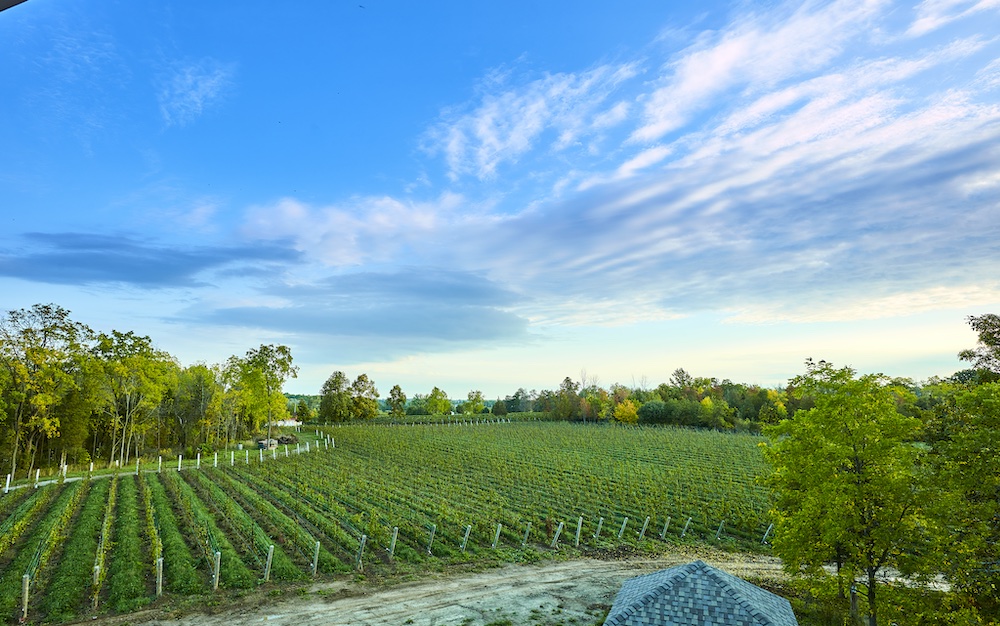
To make the best wine, Gamble and Sperling were given the tools to take every step to ensure that the Dobbin wines are “ageable, complex, harmonious, and refined.” The north and south sloping vineyards were replanted from scratch. Two rows of vines were stripped from the perimeter of the vineyards where the forest is to ensure even ripening of the grapes.
The soil in the organic vineyards has one of the highest concentrations of calcium carbonate, the chief component of limestone, Gamble has ever seen. Vines were replanted to a high density of 2,520 vines per acre (the Niagara average is 1,200 vines per acre) with drainage in every row and a full irrigation system. The low-yielding grapes are hand harvested, some single-berry selected, over several pickings to ensure acidity, structure, complexity, and ripeness. There are multiple clones of each of the four varieties.
Oh, and the most high-tech bird distraction devices I have ever seen has been purchased to solve a common problem in the vineyard. Gamble and Sperling didn’t want to use netting to keep the birds away during the harvest months to avoid “speckling” — uneven ripening of the grapes — so they found a computer operated laser system that sits on pole some 30 or 40 feet up with a view to every inch of the vineyards that sends a harmless laser beam to distract invading, grape loving birds. Laser bird deterrent technology takes advantage of a bird’s natural instincts. Birds perceive an approaching laser beam as a predator and take flight to seek safety when the laser beam passes by. It can be programmed so as not to disturb the more beneficial larger birds, such as hawks.
The winemaking gets the same royal treatment. Wild fermentation for everything, a variety of the finest French oak barrels money can buy, and long elevage across the board.
“We have the opportunity to do the full bench press here,” said Gamble as we toured the vineyard. “If we do all this, well, we should price accordingly.” And as Sperling said: “We’re trying to keep it to 2,000 case levels and put it in front of the most discerning wine drinkers. We will show them why we are different.”
The first wines are just now available for tasting and buying. The five wines reviewed below can be purchased here.
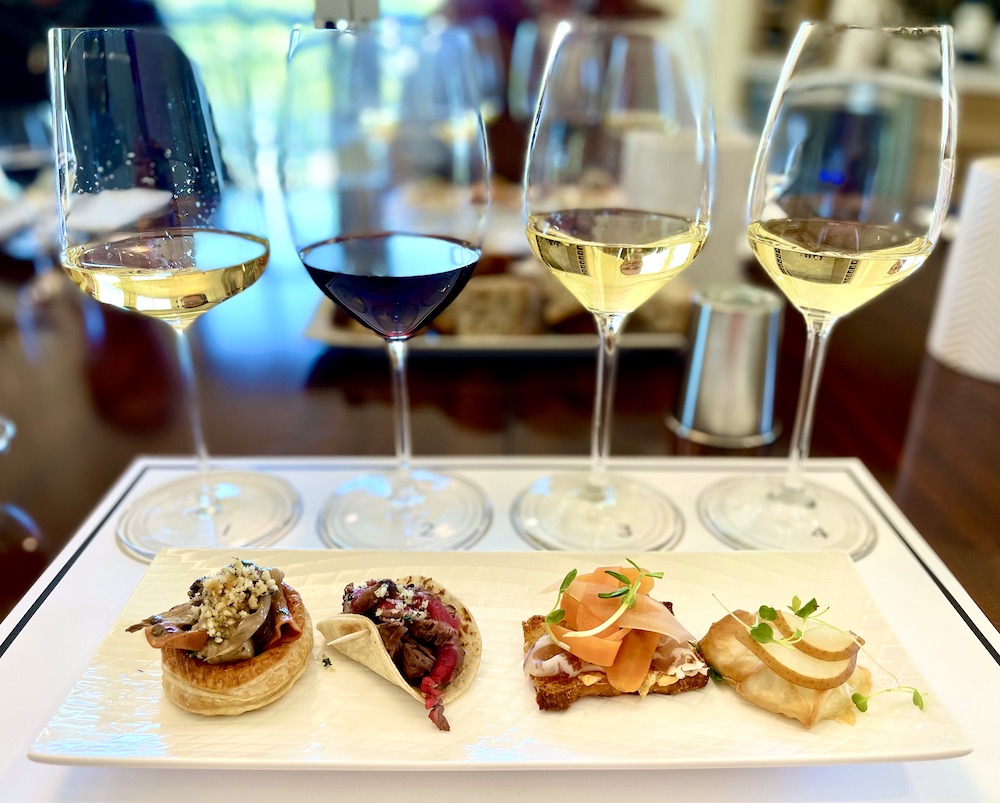
Here’s what I liked and what consulting executive chef Laura Ramik perfectly paired with these wines:
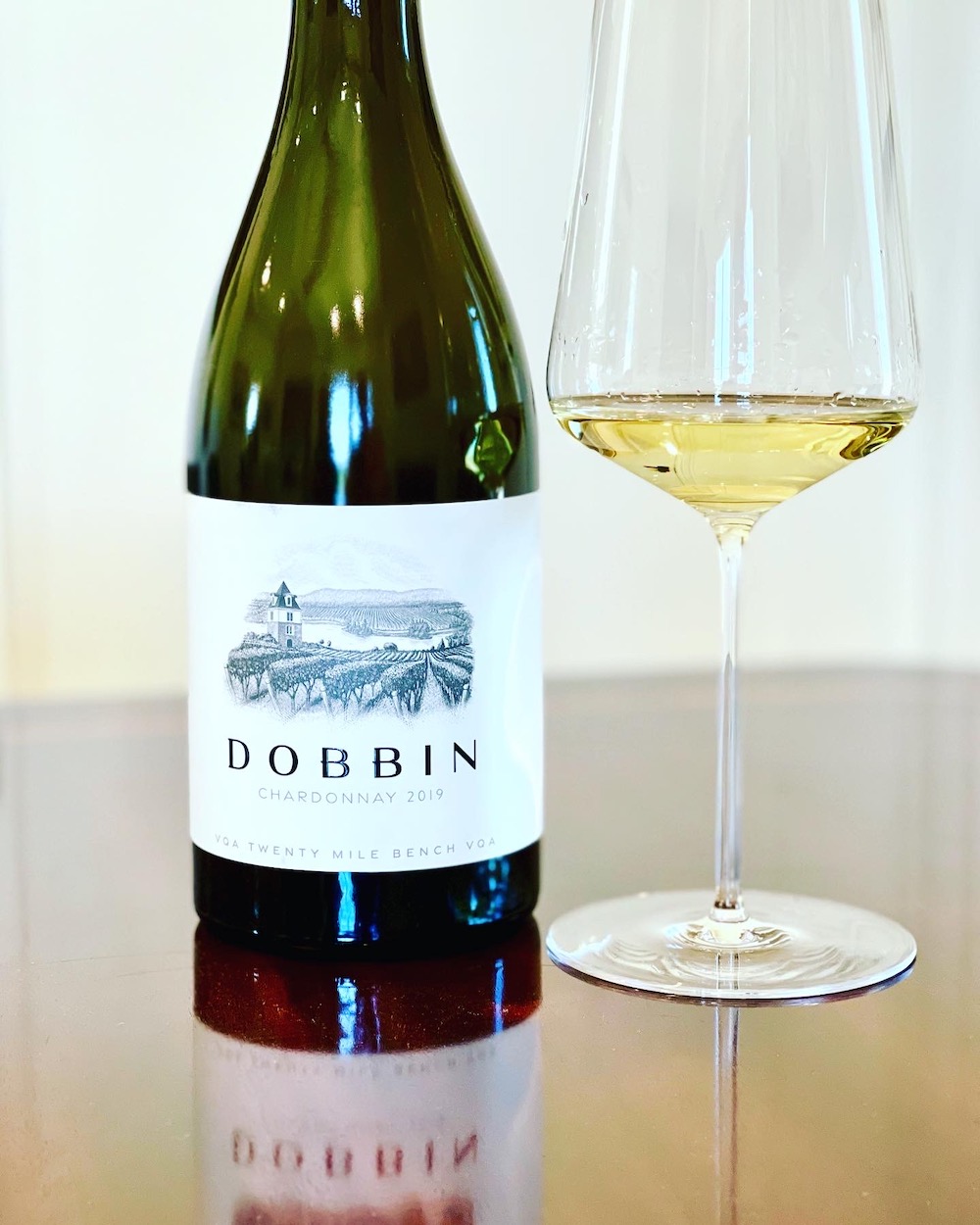
Dobbin Chardonnay 2019 ($75, 93 points) — There are only 190 cases of this soulful Chardonnay available. It’s a mix of estate fruit and a neighbouring Twenty Mile Bench vineyard. It’s anchored with grapes from the estate’s small Charlene Vineyard which consists of the original organic plantings. It was whole cluster pressed and wild fermented in French oak barrels. Secondary fermentation was also wild and aged for 18 months in French oak of varying ages. It has a penetrating nose of ripe pears, yellow apples, chalky/saline minerality, subtle savoury notes, lemon tart and perfectly integrated fine oak spice. It’s rich and luxurious on the palate with a silky texture, a textural theme that is common in all these wines, to go with concentrated pear, quince, lemon preserves, and more tantalizing spice notes that lead to a lingering and finessed finish. Can cellar this for 5+ years to 2028. 13% abv, 2.6 g/l.
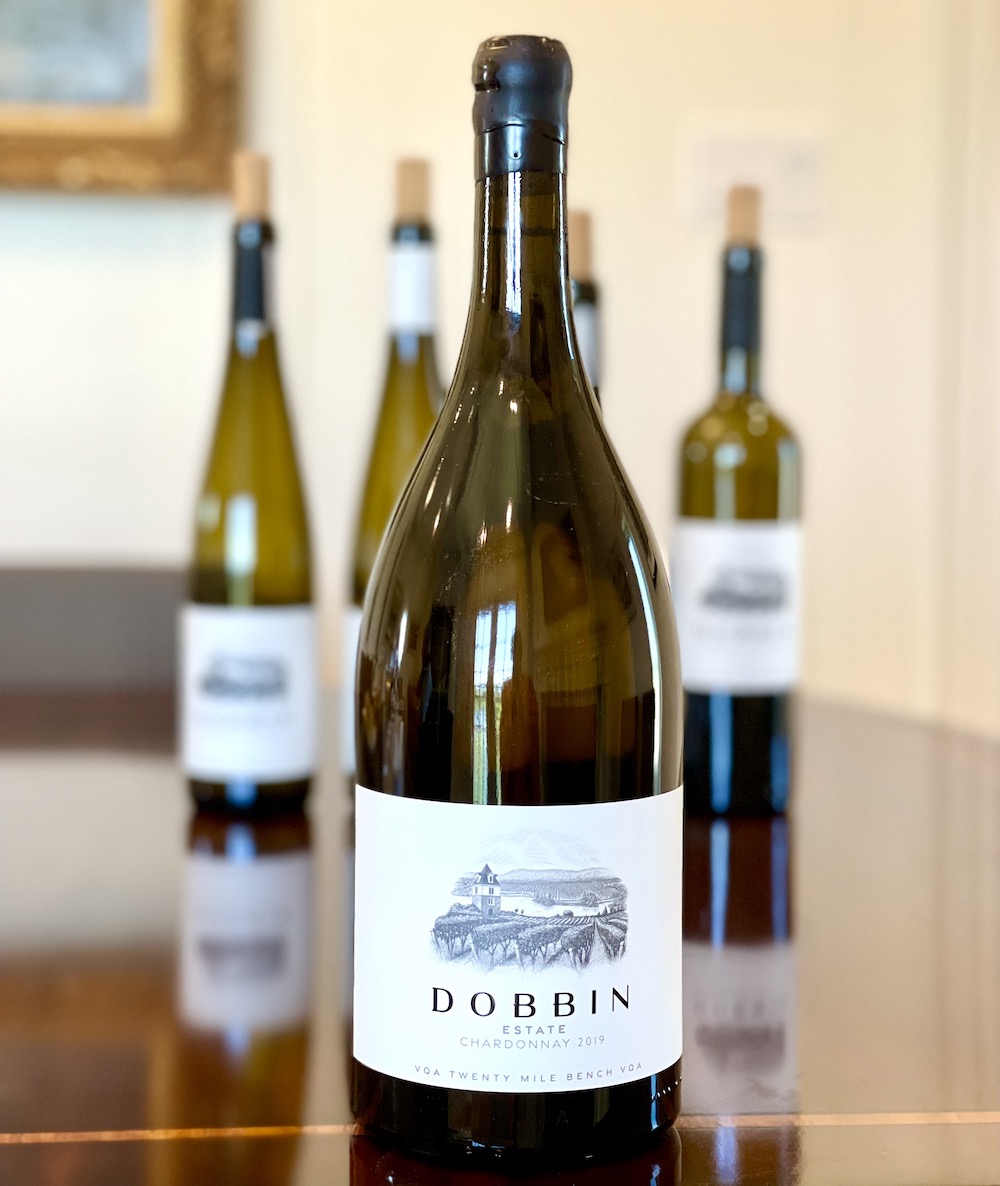
Dobbin Estate Chardonnay 2019 ($260, magnum only, 94 points) — This is a unique offering from Dobbin that is taken from one barrel of the estate’s Charlene Vineyard. “This magnum is an exciting indication of where we are going and what possibilities lie in the terroir of our special location,” the team says in its bottle notes. “These are extremely limited (135 magnums), but we wanted to share a few as it sincerely has us anticipating what we will get out of our estate plantings.” It shows a light golden colour in the glass and has a rich and concentrated nose of ripe pear, wildflowers, stony minerality, yellow apples, lemon zest and integrated spice notes. This is such a deep and concentrated Chardonnay on the palate with swirling chalky/flinty minerality, stone fruits, zesty citrus notes, toasted almonds and spice with a long, finessed and echoing finish. A treat of a Chardonnay that will improve for 5+ years in the cellar.
Chef Ramik’s pairing with the Chardonnays was a mushroom vol-au-vent with walnut crumble. The mushroom filling is made using locally grown mushrooms from Fresh Niagara Mushrooms.
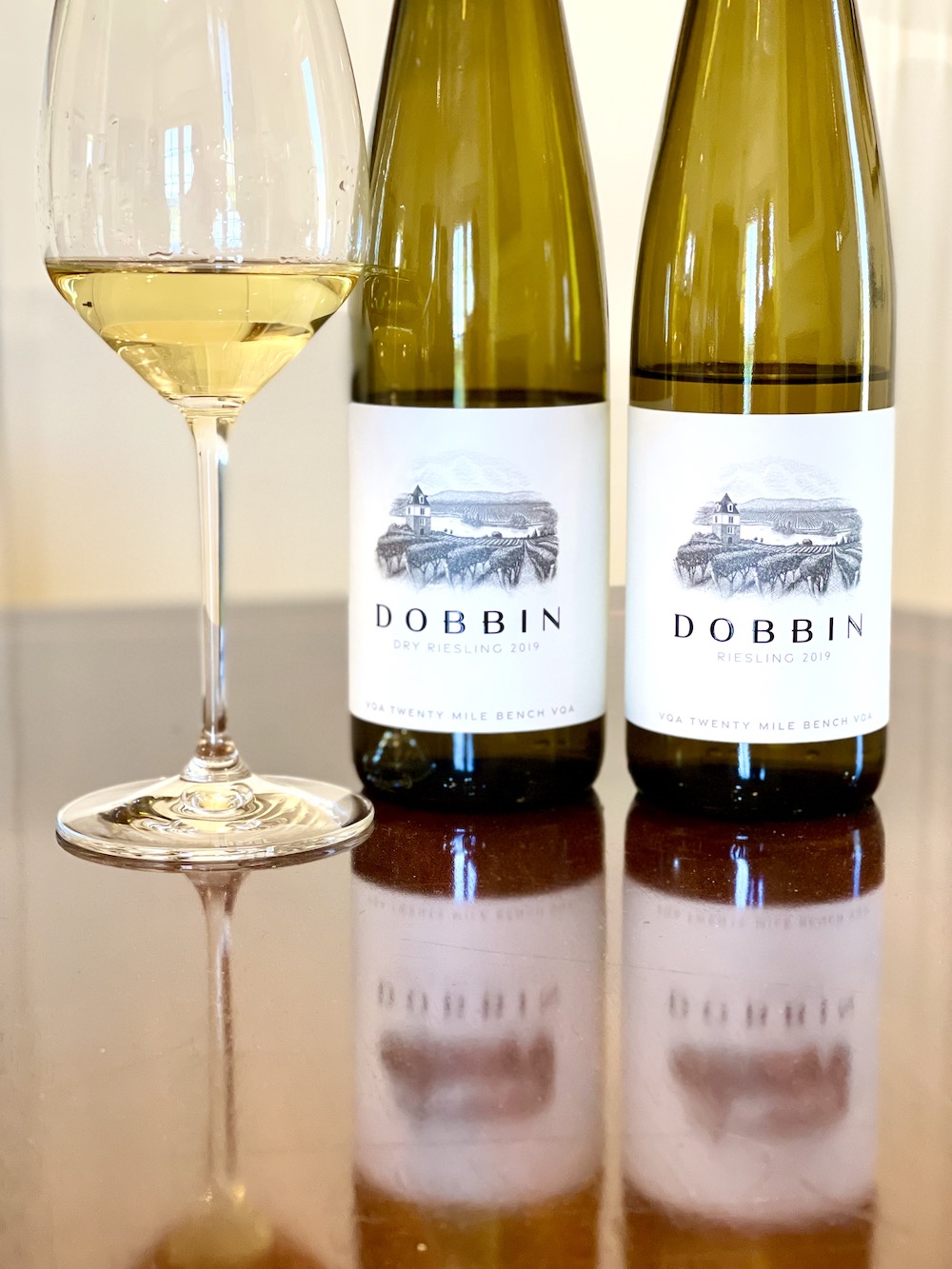
Dobbin Dry Riesling 2019 ($60, 93 points) — The grapes were manually harvested in several different passes over a period of nearly a month to provide some additional complexity through the varied acidities, ripeness, and flavour profiles of the grapes. There were short portions of skin-time and extended fermentations in primarily stainless-steel barrels. About 12% of the fruit was botrytised. This “Dry” Riesling is noted only by its black capsule in a throwback to the winemaking in Alsace, which influenced the motivation behind this wine. It has under 8 g/L of residual sugar and only 176 cases were produced. This is a very different style of Riesling for Niagara. It’s racy and open-knit on the nose and starts with a pure mineral bath of saline, chalky notes and emerging petrol followed by lime, quince, white flowers and subtle savoury notes. Wonderful concentration on the palate showing fleshy orchard fruits, zesty lime, saline, wet stones, and a long, vibrant finish. This suggests a long trip (8+ years) to the cellar if you want to push those contrasting petrol and mineral notes.
With the Dry Riesling, the Chef Ramik served a focaccia crostini with Parmesan, local coppa from Mario Pingue in Niagara Falls, pickled carrot and fresh pea shoots.
Dobbin Riesling 2019 ($65, 95 points) — This shows the kind of serious style of Riesling Gamble Sperling is zeroing in on from the estate vineyards, in this case, the small Charlene Vineyard on the western part of the property. It’s the result of several different pick dates and collecting portions of botrytis affected grapes (20%) during the harvest for separate vinifications in a mix of stainless steel and neutral larger format oak barrels. The RS is 10.5 g/L, and 107 cases were made. This is incredibly complex and keeps changing on the nose and palate as you go back to it. Lemon-lime emerges on top then wild alfalfa honey, green apples, pears, fuzzy peach skin, and subtle apricots and stony minerality. It has a fine mineral edge on the palate with flint and lanolin followed by fresh apples, peach tart, zesty lemon-lime, a hint of wild honey (not sweet) and a racy, lingering, electric finish that will keep this delightfully complex Riesling in fine form for a decade or more.
With this richer style Riesling, Chef Ramik chose a pear and baked Brie phyllo packet, topped with fresh pear and arugula.
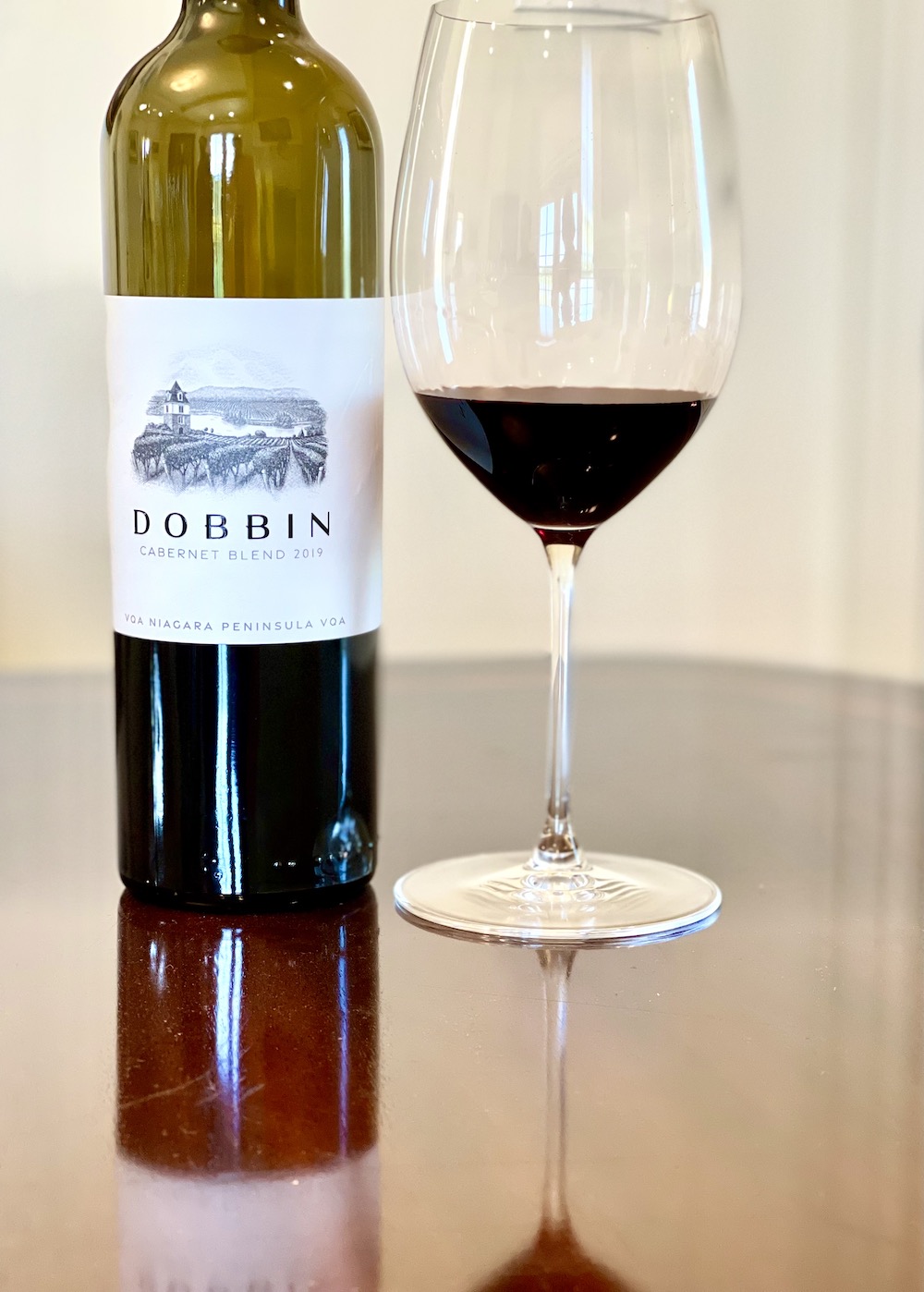
Dobbin Cabernet Blend 2019 ($80, 93 points) — Like the Riesling above, this 50% Cabernet Sauvignon and 50% Cabernet Franc blend was sourced from the original vineyard on the property. Only 75 cases were produced. It’s rich and perfumed on the nose with savoury red berries, cassis and black currants, a light peppery/savoury note and nicely integrated spice notes. It has a lovely floral note on a textured palate with a melange of black cherries, brambly raspberries, blackberries, plums, ripe tannins, and interesting fine oak nuances on a long, complex and structured finish aided by fine tannins and racy acidity. Cellar 7+ years.
The Cab was paired with Canadian beef two ways — braised shoulder and rare sirloin — garnished with lemon & parsley gremolata.








Yum – are they ready for visitors?
Yes, there’s a link in the story … you have to reserve your spot.